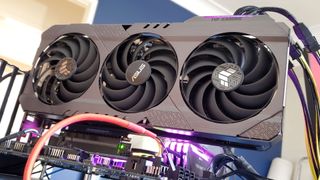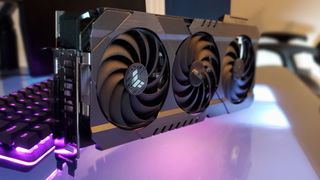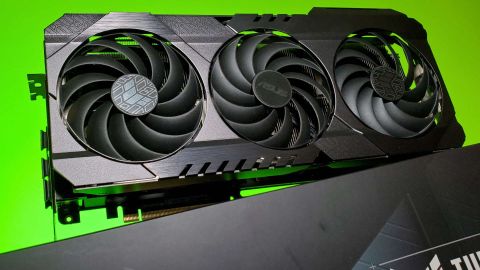Our Verdict
The RTX 3090 Ti is undoubtedly the fastest consumer GPU known to man, but it comes with a steep price and how long it remains on top is up in the air. This is as far as the Ampere GPUs can be pushed and, with the next-gen architectures from AMD and Nvidia on the way this year, its dominance could well be short lived.
For
- Top level performance
- Clocks high
- Remains cool
Against
- MASSIVE
- Expensive
- Diminishing returns
PC Gamer's got your back
The GeForce RTX 3090 Ti is a tough graphics card to love. And I'm not making that point so I can riff on the TUF naming scheme of this Asus version of Nvidia's latest and most powerful consumer GPU to date. It's a supremely beefy card in all respects—from just the physical size of the shrouds and cooling array to the level of performance on offer—but mostly because of its price.
The RTX 3090 Ti is a $1,999 card in terms of its MSRP, and thanks to the current downward trend of GPU pricing—finally actually down towards those once-mythical MSRPs—it's likely to remain at that price point. Considering the GeForce RTX 3090 was retailing for closer to $3,000 in the last few months, and is still listed for around the $2,500 mark, I guess there's a case to be made for this Ti model as a relatively affordable high-end GPU.
And today, you're looking at paying upwards of $1,200 for a GeForce RTX 3080, and potentially $1,800 for a GeForce RTX 3080 Ti. For the RTX 3090 Ti to come in at $2,000 seems like an almost generous move. But the current RTX 30-series prices aren't sustainable as stock levels continue to increase, and the new top GeForce is going to look more and more expensive as time goes on.
Though again, when you consider it against the only other comparable card using the same Ampere silicon, the Nvidia Quadro RTX A6000, which is a $5,000 professional graphics card, there's a certain value proposition. That uses the same full-fat GA102 GPU as the new RTX 3090 Ti, and the only place it improves over the GeForce card is in the sheer volume of GDDR6 memory on offer—48GB.
In those terms then, maybe the RTX 3090 Ti is a fantastic value graphics card, though only for a very specific user. A professional-level creator for whom time is money, but who cannot stretch to the prohibitive pricing of pro gear. But in real terms, for PC gamers looking for the best bang for their buck, this latest Nvidia card feels like it can only justify its GeForce branding in this very weird time for GPU supply and demand.
Nvidia RTX 3090 Ti specs



What are the RTX 3090 Ti specs?
The RTX 3090 Ti is probably the final hurrah for the Ampere generation of graphics cards. It's possible that we'll see the RTX 30-series GPUs sticking around alongside the new RTX 40-series Lovelace cards expected to drop later this year, and maybe we'll see newer spins of the older silicon popping into different gaps in the stack.
We've spoken at length about the actual Ampere architecture itself, but for a quick refresher, the main takeaway is that Nvidia has effectively doubled the number of floating point units inside the GPU's Streaming Modules (SMs) by having the secondary block of 'cores' able to calculate either integer operations or floating point operations. That basically gives these GPUs a lot of gaming grunt up front.
But there will be no more powerful example of the Ampere architecture as the RTX 3090 Ti as it's using all that the GA102 GPU has to offer. It houses the full complement of 84 SMs and therefore 10,752 CUDA cores. That also means you get 84 dedicated ray tracing (RT) cores and 336 Tensor Cores. Those are the AI matrix blocks that do good stuff in inference workloads, but also do a bit of the heavy lifting when it comes to DLSS, too.
Alongside that, really dialling into the idea of a Titan-level graphics card, is the 24GB of GDDR6X.
| Header Cell - Column 0 | RTX 3090 Ti | RTX 3090 |
|---|---|---|
| GPU | GA102-350 | GA102-300 |
| Architecture | Ampere | Ampere |
| CUDA Cores | 10,752 | 10,496 |
| Tensor Cores | 336 | 328 |
| RT Cores | 84 | 82 |
| Base clock | 1,560 | 1,395 |
| Boost clock | 1,860 | 1,695 |
| Memory capacity | 24GB | 24GB |
| Memory speed | 21Gbps | 19.5Gbps |
| TDP | 450W | 350W |
When you compare all that to the RTX 3090 this card is ostensibly replacing, and you're only really looking at another 256 CUDA cores, two RT cores, and eight Tensor cores. The memory capacity is the same, although Nvidia has used faster memory this time around, with 21Gbps memory vs. 19.5Gbps.
The noise the Asus TUF RTX 3090 Ti makes. It sounds like it's in a lot of pain.
The clock speed, however, is far higher, with the new GPU rated to boost up to 1,860MHz instead of just the 1,695MHz of the RTX 3090 Founders Edition we've tested. It's worth stating that those are the rated speeds. In testing the RTX 3090 FE ran at 1,766MHz on average, while the Asus TUF RTX 3090 Ti OC we've got here runs at an average 1,990MHz in our 4K Metro Exodus long-term stress test.
And running at 1080p it actually tops the 2GHz mark as a general average GPU clock speed.
The flip side is that it needs some monstrous cooling to be able to do so and remain at comfortable thermal levels. To the point that this Asus TUF RTX 3090 Ti is a 3.2x slot design, as opposed to the 2.7x slot design of the corresponding TUF RTX 3090. Basically, this thing is MASSIVE. It's an enormous graphics card and feels almost ungainly so. It also requires three 8-pin PCIe GPU power connectors to plumb into its triple-headed power adapter.
The 450W TGP of the RTX 3090 Ti is right in front of you. To the point that Asus has actually put a separate heatpipe array atop the power components on the TUF card's PCB. It knows it's got to keep them things chilled, or pop goes the fun times.
This is probably an appropriate time to mention the noise the Asus TUF RTX 3090 Ti makes. It sounds like it's in a lot of pain. I'm not talking about the fan sound—it remains impressively quiet under load, in fact—but the electrical whine when the card is being taxed by gaming workloads is rather hard to listen to.
The GPU is screaming. And I just feel bad putting it through such obvious suffering just to get a Horizon Zero Dawn benchmark.
Nvidia RTX 3090 Ti performance

How does the RTX 3090 Ti perform?
All you really need to know at this point is that the RTX 3090 Ti is the fastest consumer GPU on the planet and outperforms every other gaming card you could put near it. But then, at this base price, it bloody well better beat rival GPUs into a pulp.
It bloody well better beat rival GPUs into a pulp.
The issue is that as we've gone up the performance stack the price has increased significantly. Even before the combined nightmares of the GPU mining and supply chain crises the RTX 3080 was priced at $699 and the RTX 3090 at $1,499, and the performance jump didn't match the leap in price. With the RTX 3090 Ti coming in at nominally $500 more than the straight RTX 3090, a 33% increase, we've only been seeing a performance delta of between 5 and 16%.
It's interesting to note that this is almost a best-case scenario, too, as the version of Nvidia's finest we're checking out in our testing is an overclocked Asus TUF RTX 3090 Ti. This is a GPU running at a higher clock speed than the standard Founders Edition, and so the performance numbers will be slightly higher as well.
4K Gaming Performance







1440p Gaming Performance







Thermal and power performance



Professional rendering performance



CPU - Intel Core i7 10700K
Motherboard - MSI MPG Z490 Gaming Carbon WiFi
RAM - 32GB Corsair Vengeance RGB Pro @ 3,200MHz
CPU cooler - Corsair H100i RGB Pro XT
PSU - NZXT 850W
Chassis - DimasTech Mini V2
Monitor - Eve Spectrum ES07D03
It's worth stating the performance delta we're talking about here is more or less the same in both gaming and productivity terms, too. The thing is, the RTX 3090 was already an outstanding card for creators, offering far more in a consumer GPU than was ever on the table before, and far in excess of what even the RTX 3080's modern silicon could offer.
In raw rendering times, it's not necessarily a game-changer between the Ampere GPUs, but the 24GB frame buffer on the RTX 3090 means real-time manipulation of huge render models in the likes of Blender and Autodesk Maya actually is. It's not just about that final render, after all, it's the little tweaks that go on before the RTX 3090 hugely accelerates.
And the RTX 3090 Ti doesn't leap on much further.
Nvidia RTX 3090 Ti analysis


What does the RTX 3090 Ti mean for gamers?
This feels like a review of an Intel processor from the pre-Alder Lake days. Yeah, the RTX 3090 Ti is the fastest consumer GPU around today, but does that really matter? There are such diminishing returns in terms of overall gaming performance that I'd argue that $2,000 is a ridiculous ask from someone who just wants to throw around some polygons just for fun.
A frivolous extravagance for the unfeasibly well-heeled gamer.
The issue is that pricing is such a big issue today that the two grand figure almost makes sense in the market. I mean, it does when the RTX 3080 and RTX 3080 Ti are $1,200 and $1,800 respectively, but that isn't a situation that will continue for much longer. We know stock levels are on the rise, and prices are coming down, so when the RTX 3080 Ti is down to its more reasonable (though still borderline offensive) MSRP, the RTX 3090 Ti will look even more outlandishly expensive.
The price drops have already had an impact on the RTX 3090 Ti, however. We know from manufacturers that cards would have been priced some $800 higher a month or so back. It's unlikely now to drop any further, but I guess that's the benefit of the delayed launch: the RTX 3090 Ti is at least less of a wallet gouger than it was planned to be.
So yes, a frivolous extravagance for the unfeasibly well-heeled gamer that offers little extra performance over the cards it's looking to replace. But what of that professional/creator level stuff? Honestly, the RTX 3090 before it did all the heavy lifting, creating a tangible Titanesque graphics card that could rival far more expensive Quadro GPUs. The RTX 3090 Ti feels like just some $500 frosting on top—it will render slightly quicker, but the actual workflow speedup has already been done.

I still don't personally like the use of that GeForce moniker. Nvidia is at pains to state that it's a good thing, that not titling the RTX 3090/Ti as a Titan card instead has allowed it to make more versions and sell through third-party vendors and not just create the Founders Edition cards from Nvidia itself. It's suggesting, in the reviewer's guide, that these cards are "an ideal solution for content creators who need massive amounts of GPU memory, but don’t require the additional professional software optimizations found on TITAN and Quadro GPUs."
While the argument for Titan cards originally was essentially the same, they were for creators who didn't need the optimisations or support found on Quadro GPUs. I'm also pretty sure that if Nvidia wanted to call it a Titan and have third-party cards available, too, they could have done.
Calling it a GeForce card, however, immediately calls to the gamers. It is a gaming brand, after all. And that means, however much Nvidia wanted to call the RTX 3080 its flagship Ampere card at launch, the RTX 3090 was the top dog that gamers ought to aspire to, and so now is the RTX 3090 Ti. If it was named as a Titan instead I'd bet fewer gaming peops—those with ready cash to spend and maybe less of an idea of how the graphics card market stacks up—would have been looking at them to fill out the ultra-spec gaming PCs of their dreams. They'd probably appear in a different, less obvious part of the pre-built PC retail sites, too.
It's a smart play, then, and has potentially enabled Nvidia to sell more of its top-end GPUs than it otherwise might have done as a Titan. I'd just rather it was a little more up front about the reasoning. It's capitalism, we get it.
Nvidia RTX 3090 Ti verdict


Should you buy the RTX 3090 Ti?
The RTX 3090 Ti, particularly this Asus TUF RTX 3090 Ti OC Edition, is easily the fastest consumer graphics card you can buy. It's faster than any other, has more of everything than any other, and is just plain bigger than any other. It's also got a higher MSRP. By a long way. That may not mean much in this weird GPU time of ours right now, but I feel it will matter more down the line.
It's not really a card for gamers, but then it's also not really delivering much that's new for the creators, either. That speedier memory and higher clock speed do shorten the final render times, but in general usage, the RTX 3090 had already changed the game with real-time interactions.
But if you've got $2,000 to spend on a GPU today this is the one to go for. Just be aware that this is the very limit of what the Ampere architecture can do. Lovelace and the Radeon RX 7000-series cards are looming large on the horizon and could make the RTX 3090 Ti look like a Radeon VII in no time.
The RTX 3090 Ti is undoubtedly the fastest consumer GPU known to man, but it comes with a steep price and how long it remains on top is up in the air. This is as far as the Ampere GPUs can be pushed and, with the next-gen architectures from AMD and Nvidia on the way this year, its dominance could well be short lived.

Dave has been gaming since the days of Zaxxon and Lady Bug on the Colecovision, and code books for the Commodore Vic 20 (Death Race 2000!). He built his first gaming PC at the tender age of 16, and finally finished bug-fixing the Cyrix-based system around a year later. When he dropped it out of the window. He first started writing for Official PlayStation Magazine and Xbox World many decades ago, then moved onto PC Format full-time, then PC Gamer, TechRadar, and T3 among others. Now he's back, writing about the nightmarish graphics card market, CPUs with more cores than sense, gaming laptops hotter than the sun, and SSDs more capacious than a Cybertruck.

Best RAM for gaming in 2024: I've tested the best DDR4 and DDR5 RAM to find the right kits for you

Boston Dynamics' Atlas bot is dead and its replacement is horrifying yet fascinating in equal measure

Arm laptops are almost ready for prime time, and some new benchmarks with a Snapdragon X processor will have Intel, AMD and even Apple worried
